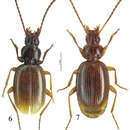Description
provided by Zookeys
Habitus as in Fig. 6.Elongated, round–sided. Body surface with a very thin, hardly visible, dense microreticulation, no more distinguishable meshes on the head.
Colour. Dorsal surface dark brown, moderately shiny. Antennae, palpi and legs light brown.
Chetotaxy. Surface of elytra glabrous with the exception of a periscutellar seta, two discal setae on the third stria, four humeral setae, four setae along lateral margin and two preapical setae. Marginal setae of pronotum present, the anterior ones located at the first anterior third of the length.
Head. Eyes flat, well–developed, temples smaller than the length of eyes, strongly wrinkled to the neck. Frontal furrows moderately deep. Antennae short (2–2.3mm) and thick.
Pronotum. Proportions (M): WP/LP = 1.3, WP/WPB = 1.35, WP/WH = 1.34, WE/WP = 1.63. Transverse, with lateral margins bordered, wider in anterior part, much less wide than elytra. Posterior part much narrower than base of elytra. One seta in the marginal gutter at about a third of pronotum length, another one just before hind angle. Sides evenly rounded and straight just between hind angles and insertions of posterior setae. Hind angles well developed, right.
Elytra. Proportions (M): WE/LE = 0.64. Subrectangular, broadest after the mid–length; surface moderately convex, flattened on disc. Shoulders distinct but rounded. Striae almost impunctuate, sixth inner discal striae distinct, but reduced at apex and base, especially in callus area; seventh striae shallower, nearly indistinct, the eighth only distinct close to apex of elytra. Apical striola well impressed continuing the fifth stria.
Hind wings. Very reduced, not functional.
Male genitalia. Median lobe of aedeagus slender, in lateral view (Fig 25) basal third curved, central part straight, parallel and elongated towards apex. Nearly symmetrical in dorsal view (Fig 13). Parameres slender, each with 4 setae at tip. Inner sac of aedeagus armed with scales with an elongate well sclerotized piece, forming a twisted gut (Fig 26). Characteristic secondary sclerotization of the sperm duct forming a kind of second copulatory piece out of the base of the median lobe (Fig 25: CP2).
- license
- cc-by-3.0
- copyright
- Arnaud Faille, Charles Bourdeau, Javier Fresneda
- bibliographic citation
- Faille A, Bourdeau C, Fresneda J (2012) Molecular phylogeny of the Trechus brucki group, with description of two new species from the Pyreneo-Cantabrian area (France, Spain) (Coleoptera, Carabidae, Trechinae) ZooKeys 217: 11–51
- author
- Arnaud Faille
- author
- Charles Bourdeau
- author
- Javier Fresneda
Distribution
provided by Zookeys
Trechus bruckoides sp. n. is only known from the calcareous plateau of Esturou located at 1860 m, north of Montagnon peak (1973 m) and Mailh Massibé (1973 m), at the northern extremity of the massifs separating Aspe and Ossau valleys (Fig. 37). South of this area (Sesques and Gaziès peaks (2600 m)), it is replaced by Trechus brucki which occurs together with Trechus distinctus. During Pleistocene glacial cycles, this plateau was covered by a névé which shaped an area of sinks of nivo–karstic origin (Auly 2008). After winter, snow remains in these sinkholes (July–August) and allows the preservation of a nivicolous fauna, which is unusual at these medium altitudes. Trechus bruckoides sp. n. lives exclusively in the masses of fallen rocks of sinkholes and follows the withdrawal of the snow. When the snow thaws it likely seeks refuge underground.
This mid altitude nivicolous environment could have led to isolation of populations of the species from southern glaciated areas and glacial tongues of the northern slope of Ossau glacier and led to the differentiation of this population of cryophilic and highly hygrophilic Trechus. Such a hypothesis could also explain the presence of the hypogean Trechini Aphaenops bessoni Cabidoche, 1962, endemic to this karstic plateau (pits of Col d’Aran), and closely related to Aphaenops loubensi Jeannel, 1953, an endemic species of the Pierre Saint Martin massif, western to the Aspe Valley. Some other endemic nivicolous Carabidae with morphologically distinct populations occur in the area, like Carabus (Iniopachus) pyrenaeus Audinet–Serville, 1821 (the population of Sède de Pan was first described as a distinct subspecies, Carabus pyrenaeus cephalicus Csiki, 1927), Nebria lafresnayei Audinet–Serville, 1821, Pterostichus (Cryobius) amoenus mascarauxianus Pupier, 2008, Pterostichus (Lianoe) nadari mascarauxi Jeannel, 1928 and Pterostichus (Lianoe) dufourii (Dejean 1828). The peculiarities of this fauna suggest that this restricted area is an important center of diversification.
- license
- cc-by-3.0
- copyright
- Arnaud Faille, Charles Bourdeau, Javier Fresneda
- bibliographic citation
- Faille A, Bourdeau C, Fresneda J (2012) Molecular phylogeny of the Trechus brucki group, with description of two new species from the Pyreneo-Cantabrian area (France, Spain) (Coleoptera, Carabidae, Trechinae) ZooKeys 217: 11–51
- author
- Arnaud Faille
- author
- Charles Bourdeau
- author
- Javier Fresneda

